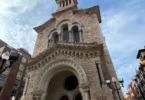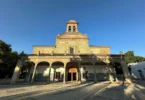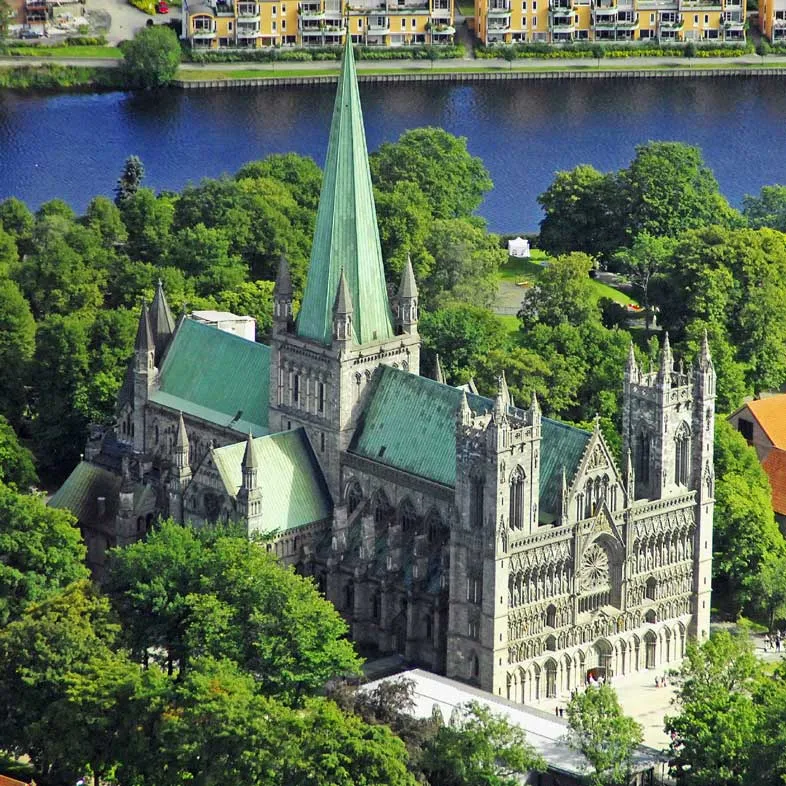
Introduction
Nidaros Cathedral (Norwegian: Nidarosdomen / Nidaros Domkirke) is a Church of Norway cathedral located in the city of Trondheim in Trøndelag county, Norway. It is built over the burial site of King Olav II (995 – 1030, reigned 1015 – 1028), who became the patron saint of the nation, and is the traditional location for the consecration of new kings of Norway. It was built over a 230-year period, from 1070 to 1300 when it was substantially completed. However additional work, additions and renovations have continued intermittently since then, including a major reconstruction starting in 1869 and completed in 2001.
In 1152, the church was designated as the cathedral for the Catholic Archdiocese of Nidaros. In 1537, during the Protestant Reformation, it became part of the newly established state Church of Norway. It is the northernmost medieval cathedral in the world.
The cathedral is the main church for the Nidaros og Vår Frue parish, the seat of the Nidaros domprosti (arch-deanery), and the seat of the Bishop of the Diocese of Nidaros. The Preses of the Church of Norway is also based at this cathedral. The church seats about 1,850 people.
Right in the heart of Trondheim is Nidaros Cathedral. Norway’s national shrine, a richly decorated Gothic masterpiece.
The cathedral is built over the grave of Olav the Holy, the Viking king who Christianized Norway and became the entire country’s eternal king. Throughout the Middle Ages, it stood as a towering symbol of people’s faith in God and the church’s powerful position.
The Nidaros Cathedral was begun in 1070 and was completed in all its glory around the year 1300. After several fires and a lack of maintenance, the cathedral was in a very poor condition at the beginning of the 19th century. In 1868 it was decided that the cathedral should be rebuilt as a national symbol, and the major work began the following year. The restoration of Nidaros Cathedral has been going on for 150 years, but around 30 craftsmen are still working continuously on various projects at the national shrine.
Trondheim, or Nidaros as the city was formerly called, was Northern Europe’s most important pilgrimage destination in the Middle Ages. Pilgrims came here from far and wide to visit the grave of Olav the Saint. Today, the pilgrimage tradition has been brought back to life, and pilgrims are again flocking to Nidaros Cathedral.
Nidaros Cathedral is the world’s northernmost Gothic medieval cathedral. A visit to the cathedral is experienced differently throughout the different seasons. In autumn and winter it is easy to be fascinated by the thousands of small and large soapstone sculptures, which give the cathedral a mysterious expression in the dark season. In spring and summer, you can experience a wonderful light inside the cathedral, when the sun shines through the colorful rose window.
History of Nidaros Cathedral, Norway
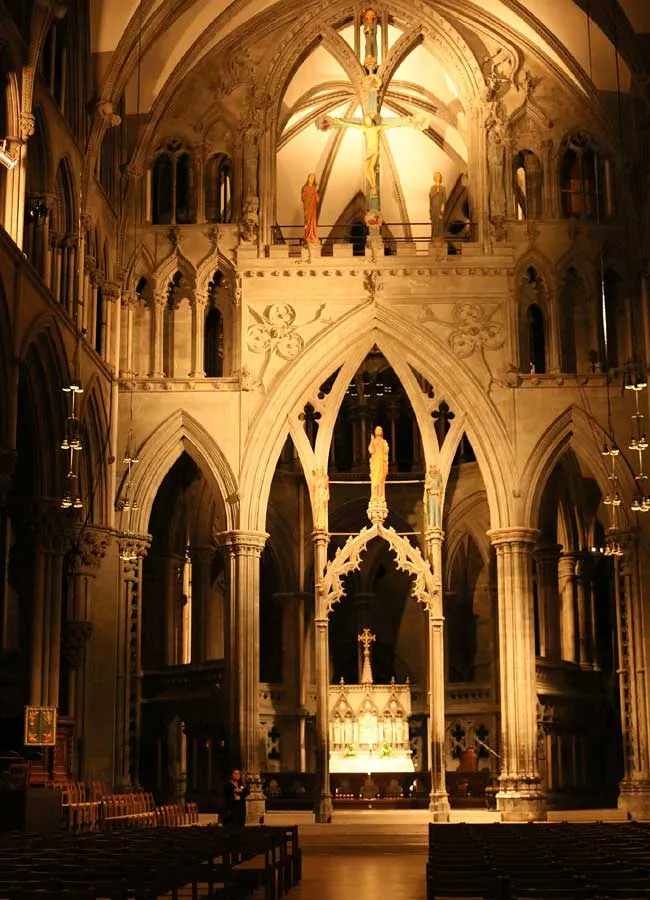
Nidaros Cathedral was built beginning in 1070 to memorialize the burial place of Olav II of Norway, the king who was killed in 1030 in the Battle of Stiklestad. He was canonized as Saint Olav a year later by Grimketel, the Bishop of Nidaros (the canonization was later confirmed by the pope). It was designated the cathedral of the Catholic Archdiocese of Nidaros from its establishment in 1152 until its abolition in 1537 under the Reformation.
Since the Reformation, it has served as the cathedral of the Lutheran bishops of Trondheim (or Nidaros) in the Diocese of Nidaros. The architectural style of the cathedral is Romanesque and Gothic. Historically it has been an important destination for pilgrims coming from all of Northern Europe.
In 1814, this church served as an election church (Norwegian: valgkirke). Together with more than 300 other parish churches across Norway, it was a polling station for elections to the 1814 Norwegian Constituent Assembly which wrote the Constitution of Norway. This was Norway’s first national elections. Each church parish was a constituency that elected people called “electors” who later met together in each county to elect the representatives for the assembly that was to meet in Eidsvoll later that year.
Along with Vår Frue Church, the cathedral is part of the Nidaros og Vår Frue parish in the Nidaros deanery in the Diocese of Nidaros.
Building and Restoration
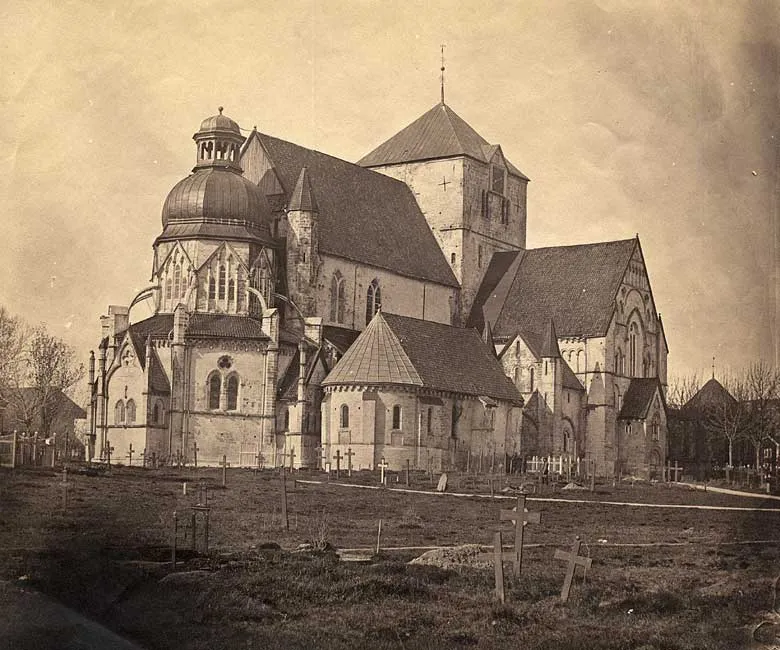
Work on the cathedral as a memorial to St. Olav started in 1070. It was finished sometime around 1300, nearly 150 years after being established as the cathedral of the diocese. The cathedral was badly damaged by fires in 1327 and again in 1531. The nave was destroyed and was not rebuilt until the restoration in early 1900s.
In 1708, the church burned down completely except for the stone walls. It was struck by lightning in 1719, and was again ravaged by fire. Major rebuilding and restoration of the cathedral started in 1869, initially led by architect Heinrich Ernst Schirmer, and nearly completed by Christian Christie. It was officially completed in 2001. Maintenance of the cathedral is an on-going process.
The oldest parts of the cathedral consist of the octagon with its surrounding ambulatory. This was the site of the original high altar, with the reliquary casket of Saint Olav, and choir. Design of the octagon may have been inspired by the Corona of Canterbury Cathedral, although octagonal shrines have a long history in Christian architecture. Similarly, the choir shows English influence, and appears to have been modeled after the Angel Choir of Lincoln Cathedral.
It is joined to the octagon by a stone screen that fills the entire east side of the choir. The principal arch of this screen is subdivided into three subsidiary arches: the central arch frames a statue of Christ the Teacher, standing on the top of a central arch of three subsidiary arches below him. The space above the principal arch, corresponding to the vault of the choir, contains a crucifix by the Norwegian sculptor Gustav Vigeland, placed between statues of the Virgin Mary and the Apostle John. Built into the south side of the ambulatory is a small well. A bucket could be lowered to draw up water drawn from the spring that originated from St. Olav’s original burial place.
Architecture of Nidaros Cathedral, Norway
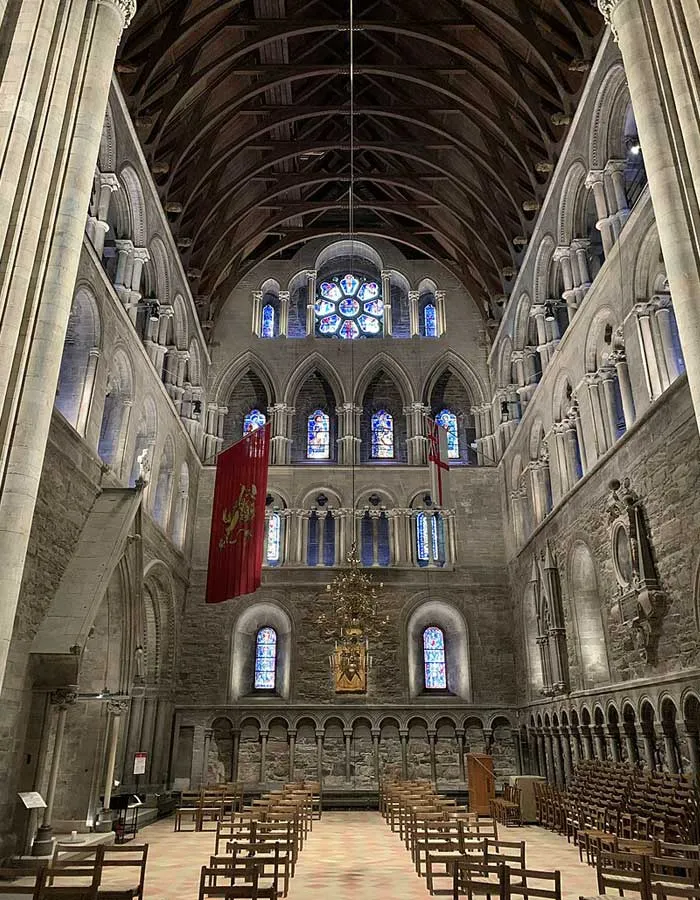
The present cathedral has two principal altars. At the east end of the chancel in the octagon is an altar at the site of the medieval high altar, behind which stood the silver reliquary casket containing the remains of St. Olav. This silver-gilt reliquary casket was melted down for coinage by Christian II and St. Olav’s remains buried in an unknown location under the cathedral. The only relic known to have survived is a femur in a silver-gilt reliquary. Shaped as a forearm, it was given by Queen Josephine to St. Olav Catholic Cathedral in Oslo. The original reliquary casket was in the form of a church, with dragon heads on its gables.
The dragons are similar to those carved on the gables of Norwegian stave churches. Surviving medieval reliquary caskets in Norway frequently also bear such dragon heads, for instance, that at Heddal Stave Church. He was the church’s and the kingdom’s patron saint. The current altar was designed to recall in marble sculpture the essential form of this reliquary casket. It replaces the previous baroque altar, which was transferred to Vår Frue Church.
The second altar is in the crossing, where the transept intersects the nave and the chancel. It bears a large modern silver crucifix. It was commissioned and paid for by Norwegian American emigrants in the early twentieth century, and the design was inspired by the memory of a similar silver crucifix in the medieval church. The medieval chapter house may also be used as a chapel for smaller groups of worshipers.
All the stained glass in the cathedral dates from its rebuilding in the 19th and 20th centuries. The windows on the north side of the church depict scenes from the Old Testament against a blue background, while those on the south side of the church depict scenes from the New Testament against a red background.
Organs
Nidaros Cathedral has three very important Organs.
The Steinmeyer Organ
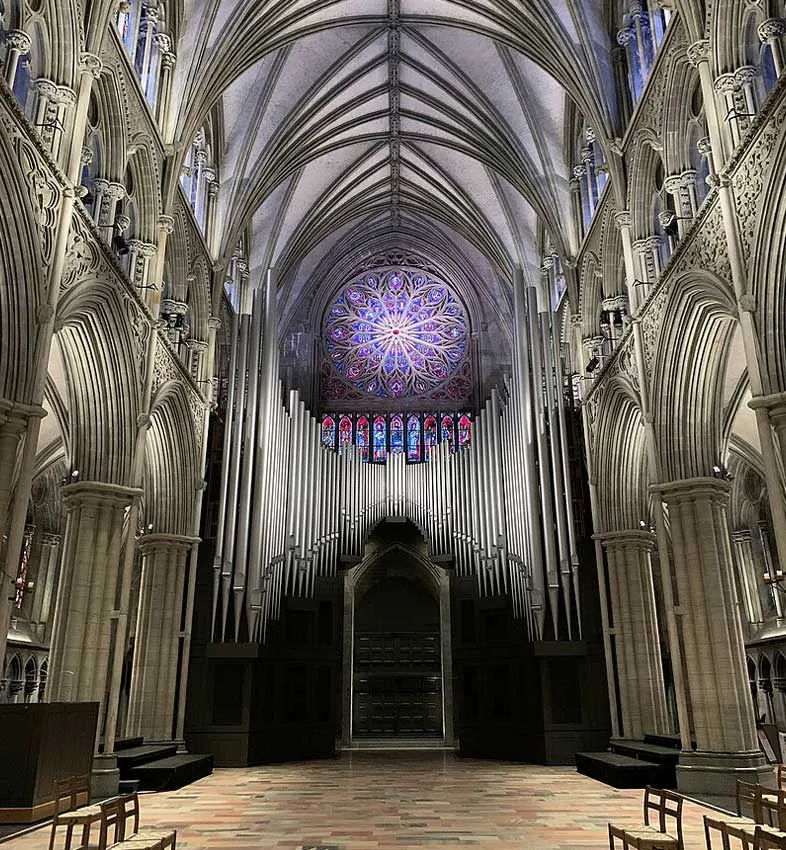
The church’s main organ is a romantic instrument from 1930, built by the German company G.F. Steinmeyer was erected in the north transept. It then had 125 stops. Installation of the Steinmeyer organ was commissioned in 1930 for the 900th anniversary of the Battle of Stiklestad. The organ was funded mostly by donations, particularly by Elias Anton Cappelen Smith. In 1962, the organ was heavily rebuilt and moved to the west nave. Many stops were removed; some of them were used to build a new choir organ. In 2007 a decicion was made to start a restoration process. Orgelbau Kuhn AG from Switzerland restored the organ, and it was inaugurated in 2014.
With its 127 voices and seven works divided between four manuals and a pedal, it is one of the largest church organs in Scandinavia. It is installed in the western part of the cathedral.
The Wagner Organ
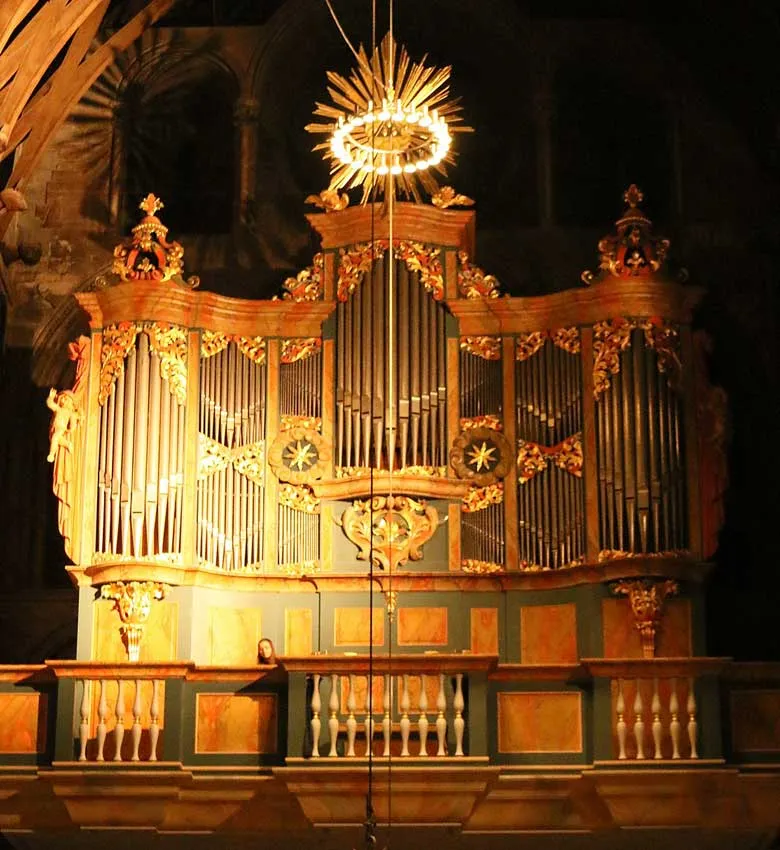
We also have a cultural treasure in the northern transept; the Wagner organ – a baroque organ from 1741, built by German organ builder Joachim Wagner (1690–1749) during the period 1738–40 was carefully restored by Jürgen Ahrend between 1993 and 1994. It has 30 stops and is located at a gallery in the north transept. Large Baroque organs in such good condition are unusual, and the organ is considered a national treasure.
The Choir Organ
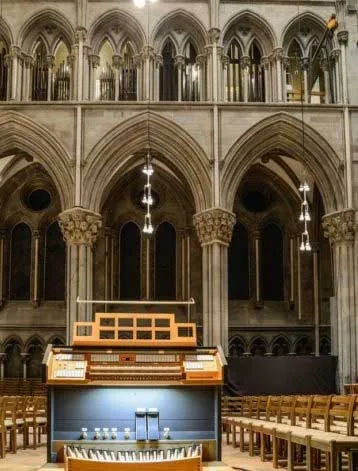
Nidaros Cathedral’s third large organ, mainly located in the church’s east nave.
Tourist Attraction
Today, the cathedral is a popular tourist attraction. Nidaros Cathedral is the site of the observation of Olav’s Wake (Norwegian: Olavsvaka). This religious and cultural festival is centered upon the anniversary of the death of Saint Olav at the Battle of Stiklestad. Tourists often follow the historic Pilgrim’s Route (Norwegian: Pilegrimsleden) to visit the cathedral for this and other events.

Alleged Bombing Plot
The cathedral is also familiar to enthusiasts of Norwegian black metal, as it is featured on the cover artwork of De Mysteriis Dom Sathanas, the 1994 studio album by Mayhem. It was rumored that members of the band who had already been associated with the burnings of other Christian churches in Norway had planned to destroy the cathedral in relation to the release of the album. When police arrested former Mayhem bassist Varg Vikernes on 19 August 1993 they had found 150 kilograms (330 lb) of explosives in his home.
Choirs

- Nidaros Cathedral Choir
- Nidaros Cathedral Boys’ Choir
- Nidaros Cathedral Girls’ Choir
- Schola Sancta Sunnivae
- Nidaros Vocalis
- Nidaros Oratory Choir
The West Front
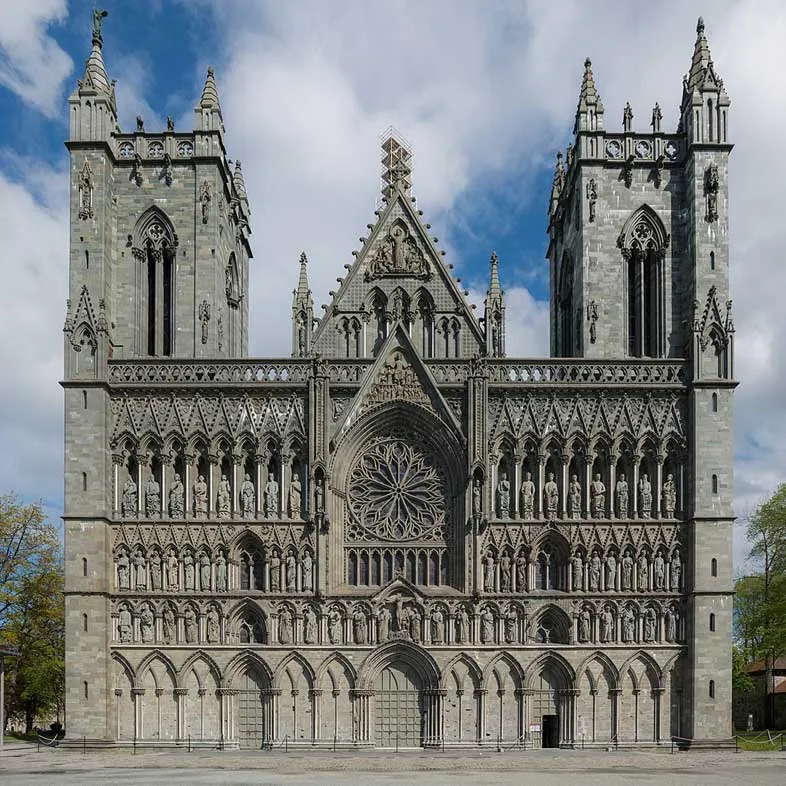
The West Front is the Cathedral’s beautiful and ornate façade towards the west. It is designed as a screen front, consisting of two western towers and a wall that connects them.
The Stained Glass Windows

A stained glass window consists of many coloured or stained pieces of glass, pieced together with strips of lead to form a mosaic.
The Sami Altar
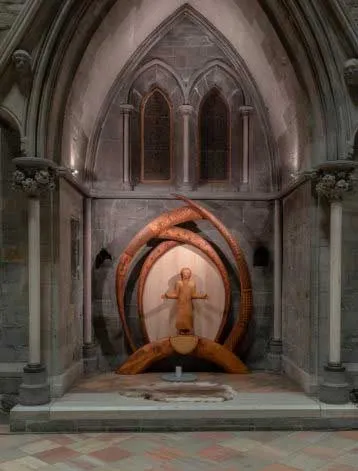
The Sami altar of Nidaros Cathedral was consecrated during “Tråante”, The centennial of the Sami Assembly, in 2017. The altar was created by South Sami artist, Folke Fjällström.
Feast Day - 29th July
Annual Feast Day of Nidaros Cathedral, Trondheim, Norway is celebrated on 29th July.
The feast of St. Olaf on 29 July was a day of reunion for “all the nations of the Northern seas, Norwegians, Swedes, Goths, Cimbrians, Danes and Slavs” in the cathedral of Nidaros, where the saint’s reliquary was near the altar. Built in Romanesque style by King Olaf Kyrre. His tomb was a site of pilgrimage.
Mass Time
Sundays
Church Visiting Time
Contact Info
Kongsgårdsgata 2,
7013, Trondheim, Norway.
Phone No.
Tel : +47 73 89 08 00
Accommodations
How to reach the Cathedral
Trondheim Airport, more commonly known as Værnes, is an international airport serving Trondheim, a city and municipality in Trøndelag county, Norway is the nearby Airport to the Cathedral.
St. Olavs Gate Light Rail Station in Trondheim, Norway is the nearby Train Station to the Cathedral.





